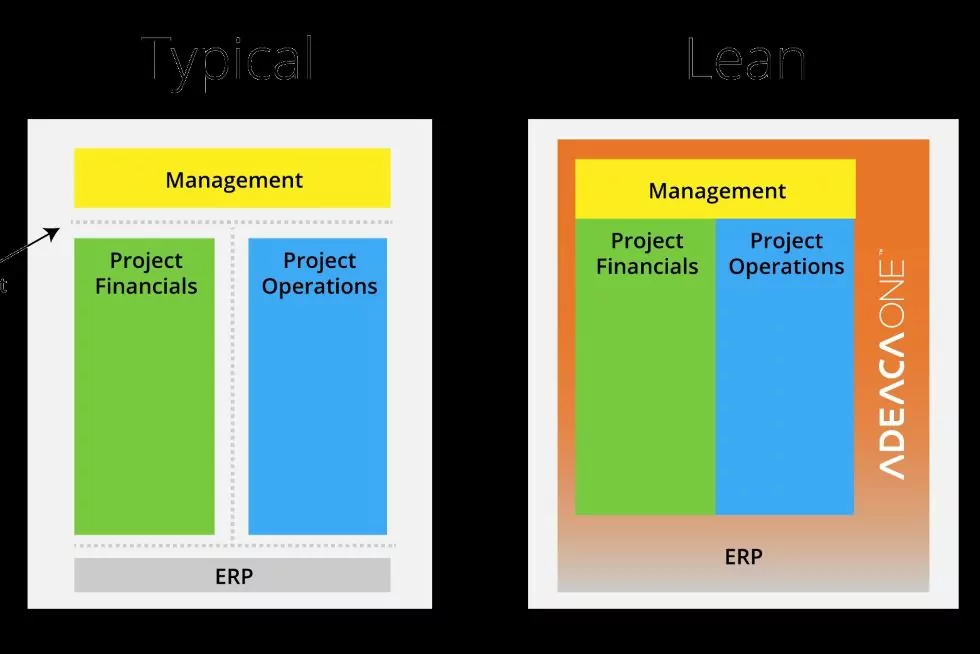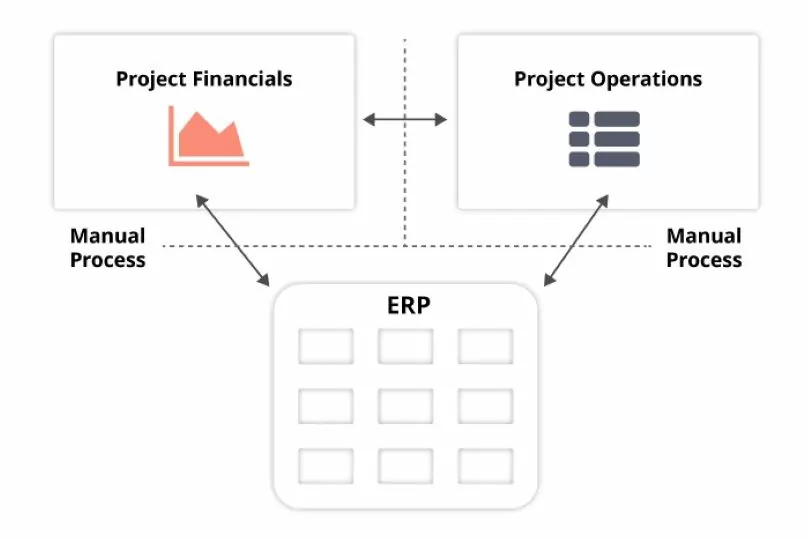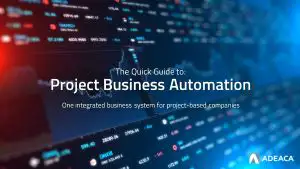In a prior blog, Separation of Operations, Finance and ERP is Seriously Holding Back Project Industries, I wrote about the sorry state of project industries and their structural problems. In this this blog, I want to follow up and make the case for the “lean project enterprise” principles that can provide a solution to every company that is project oriented in nature.
Attempting to apply lean principles to project-based organizations is not new. Various lean attempts have been made to sub-optimize the operational side of the project business, but with little adoption and effect. I would argue the reason is because the operational side is already well optimized. It is the departments outside of operations and their lack of process integration and alignment with operations that holds these companies back (read before mentioned blog).
We believe that if you apply lean principles to the organization as a whole, through process realignment and system consolidation, all project companies can reap valuable benefits from a lean approach, similar to what we have seen for non-project industries.
This article explains what we mean by applying lean principles to the project organization and what the components are that can make it successful.
Before we begin, I want to point out that we have come to these conclusions by working closely with a wide range of project organizations adopting our software solutions in the real world, and not necessarily through an academic approach. We fully understand that more research needs to be done to uncover the principles behind the “Lean Project Enterprise” more comprehensively, and we would invite anyone with academic or research interest in the topic to contact us.
Origins of Lean
Lean manufacturing management philosophy has its origins in the Japanese automobile industry. The base principles of lean manufacturing date back to the 1950s with the development of Toyota Production System (TPS). Outside of Japan, lean manufacturing began to gain popularity in the 1990s often accredited to the publication of Womak & Jones The Machine that Changed the World.
Lean management is a systematic approach to waste reduction and value maximization.
Every step in every process should be optimized as much as possible to eliminate waste and thereby maximize its value for the customer. Assuming your costs are covered the fees you charge your customers, that means that your customer pays for your wasted resources. Being lean is about eliminating that waste and thereby maximizing the value to your customer.
Adaptations of Lean
Today, the lean principle has been adapted to industries far beyond manufacturing. We have seen lean IT, lean management in healthcare, lean service management, lean construction and many more. We have also seen lean project management specifically targeted at software development. With the impressive productivity and quality improvements recorded by companies successfully adopting the lean principles it is hardly surprising that project industries have taken an interest. Still, the successful uptake and execution of lean principles in project-based organizations remain modest.
Why Lean Fails for Projects
Around 20% of all companies are project-based. Whether you call them projects, engagements, jobs, or service contracts, if you earn revenue by conducting discontinuous client endeavors that are limited in time and scope, your business is a project-based business, and your needs are fundamentally different than traditional manufacturing, retail, or distribution companies.
For project industries, we have seen attempts at lean project management, lean construction and lean ETO manufacturing to name a few. However, we have not seen the widespread pervasive success and subsequent adoption as we saw in manufacturing. Why?
First, when we look at project businesses, we can see they operate differently than most other companies. Operationally as well as financially, project industries are faced with significantly higher levels of uncertainty and risk due to the inherent volatility of projects where change is ever present and repeatability across individual projects is often very low. This does not negate the value of lean thinking but requires additional emphasis on managing uncertainties and synchronizing the many constantly moving parts which goes into the execution of a project.
We believe the problem stems from implementing lean at the wrong level of the business.
Most applications and systems for lean are applied only to the production silo of the business and not the business as a whole.
For example, there are many point solutions that address some part of the construction management process for construction and specialty contractor companies. That may help improve certain low-level functions (critical path planning, lean inventory control), but it doesn’t help the business run better overall.
The rest of the business remains in silos. The inefficiencies at the top layers of the business remain due to lack of transparency that hampers sounds decision making. Lack of process alignment between departments remains untouched by these point solutions. This separation of project operations, project financials and back-office business processes (ERP) significantly hinders project companies’ ability to perform as well as they could.
That is why we felt the need to elevate the lean effort to the enterprise level. We should approach the company from the top down. That way we encompass the entire company and significant improvements can be made through business process realignment. Hence, the title of this post – The Lean Project Enterprise.
Becoming a Lean Project Enterprise
The lean management philosophy is focused on continuous development of business process standards aimed at adding customer value and eliminating waste. When lean principles are applied properly, dramatic improvements in quality and efficiency can be achieved.
In project industries, improvements at the process and enterprise levels are enablers that make project level improvements more successful and allow such improvements to be sustainable and repeatable. From a business application perspective, to successfully adopt lean principles, companies need to align business processes across the entire enterprise, ensure corporate practices & standards are followed while maintaining the agility required to react fast and effectively to variations, disruptions, and exceptions.
One major reason project companies have not been able to adopt lean is due to the solutions being used. Of course, it is about the processes, but in today’s world the technology utilized to enable those processes plays a significant role. If you rely on systems and applications, you cannot use ones that artificially divide the company and expect a unified result.
With that in mind, below are three areas we have identified in our experience as key to becoming a lean project enterprise.
1. Align & automate
Project based organizations tend to rely on multiple point solutions to manage critical business processes. A typical application setup for a project driven company includes at a minimum a financial backend application, a scheduling tool and a range of Excel sheets and homegrown desktop applications to manage everything else. The result is that project-based organizations find it hard to align departments, divisions, and processes, which is hardly surprising as each piece remains siloed in its own application.
The main areas we see as problematic is the separation of project financials, operations, and ERP:
This is in stark contrast to manufacturers who since the late 1980s began transitioning from point solutions to single integrated Enterprise Resource Planning (ERP) applications. Perhaps it is no coincidence that productivity in project industries, such as construction has improved far less than the world average over the past three decades.
The answer is to align business processes and systematize those so wherever possible, manual processes can be replaced with automated ones. This reduces waste across various project business processes by eliminating unnecessary labor and reducing the delay in information dissemination. All stakeholders are updated always in real time.
As an example, we chose to move two important business areas into the ERP system to thereby force an alignment among them all:
2. Increase agility
Aligning and automating inevitably leads to increased agility, a central trademark of the lean enterprise. This is especially critical in project industries with often a low degree of repeatability across projects and a high level of uncertainty. The ability to detect and react to changing circumstances is critical in reducing costs and improving productivity while meeting client deadlines and requirements.
It requires manual intervention to align business processes that span across isolated business applications. When inter-related processes are not automatically aligned, it slows down the organization and degrades its ability to react fast and effectively.
While processes can be manually realigned very few organizations succeed in doing this consistently and effectively. True agility requires an alignment of business processes and a systematized flow of information that occurs in real-time.
3. Enforce best practices
Lean thinking requires close analysis of value streams and redefining of business processes to eliminate waste. To execute on lean principles the enterprise must ensure that defined processes are being followed.
Improvements cannot be made to a disjointed environment with departments and even individuals dictating their own processes. Running your business in a fragmented application setup makes it very difficult to implement enterprise-wide common standards and best practices. When critical business processes are managed in desktop applications and spreadsheets, you effectively rely on individuals rather than corporate guidelines. This results in a low degree of business process predictability, making it hard to enforce a scalable and repeatable business model that generates consistent results.
Moreover, optimizing productivity cannot be done without metrics. If processes are not standardized, they cannot be measured and improved upon.
Conclusion
In sum, I believe we have uncovered a novel approach to apply lean principles to project organizations through process realignment and system consolidation. Through more than a decade of working with our customers and developing systematic enhancements in project processes, we have seen significant improvements in many different project companies from various industries.
The culmination of our efforts to date is ADEACA ONE, what we call a Unified Project Solution. We think this approach can help many companies in project-oriented industries, and we invite you to explore the lean project enterprise with us. Contact us to find out more or to let us know your thoughts.












